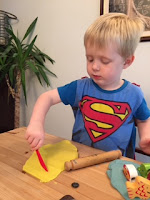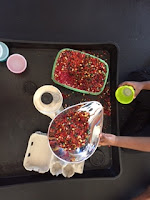What is messy play?
 |
| Play dough - my favourite! |
 |
| Rainbow foam - so tempting to jump into! |
From the sound of it,
messy play is every mother’s nightmare yet it is considered a very important
part of children’s learning through play. Exploring a wide range of different sensory
experiences is incredibly valuable to a child’s cognitive and creative development.
 |
| Jelly is so much fun! And edible for those who like to explore with their mouths!! |
 |
| Making potions with herbs and water - great sensory play! |
 |
| The children loved exploring scales using the coloured rice. |
 |
| So pretty! Who wouldn't want to play? |
Coloured Rice:
This is incredibly easy to make yet makes such a beautiful invitation to play. Pour some rice in a zip lock bag, add a few
drops of food colouring, close and mix it together. Once it is all coloured, pour
onto a tray to dry. A great tool for practising pouring, measuring, exploring
noise makers by putting different amounts into bottles and jars. This will last for months as long as it doesn’t get wet.
Coloured spaghetti – cook your spaghetti as usual, drain it and run cold water through it (this prevents sticking). Rub a few drops of olive oil into it and then a few drops of food colouring. Allow to dry a little (just so food colouring sticks) and then play!! This is very cool for making discovery tubs and hiding things such as numbers or animals in. NB, this won’t last for very long so make it when you can use it for a day or 2 in a row.
 |
| The bowl of 'ice cream' my son made me last week! |
Play dough:
This is probably my all time favourite item and deserves its own blog post really - watch this space! It is a great stress reliever (for adults as well as children!), strengthens fingers and co-ordination (is vital
for future handwriting skills) and is so open ended that the creativity is
endless. For the best play dough ideas I cannot recommend Anna from the imagination
tree highly enough so check out her page and her brilliant no-cook recipe. https://theimaginationtree.com/best-ever-no-cook-play-dough-recipe/
Not only can you colour the play dough but scenting it with essential oils, cooking essences, herbs and spices add a whole new sensory experience as will providing different objects to play with it such as sticks, stones, seeds etc.
 |
| Seaside invitation to play with 2 coloured play dough, shells and sea creatures. |
 |
| Painting with coloured ice cubes -great for hot days! |
Paint:
Paint is not just to be used on paint brushes or even just for flat surfaces.
Finger printing, hand printing, foot printing, on paper, foil, stones, on the
ground, on a table, stuck on a wall ... the possibilities are endless. I
especially like giving different orientations for painting – using an easel or
having the paper stuck to the wall is really great for encouraging crossing the midline (an imaginary line down the centre of your body from your head to your toes)which helps the different sides of the brain talk to each other and aids development of gross motor skills.
 |
| Paint and fly swats - some awesome process art. |
We love messy play at the Honeycomb Hub and the
best thing about coming to the classes? You don’t have to clear it up!! This
week’s session on Wednesday 7th February is all using edible materials so perfect for the little ones who still explore everything by putting
it in their mouths. Also a great opportunity to sit back with a complimentary cup of tea and really watch how your child is exploring the world around them. We are also offering a messy play session as an option in our party packages at The Honeycomb Hub.
 |
| The windows just looked too plain! Look at that enjoyment as he uses a whole other set of muscles to control the brush in this orientation. |
 |
| Outside painting on huge paper - great fun! |





Oh I wish I was three again!!
ReplyDeletewonderful
ReplyDeleteMichelle, I think messy play could be for any age - I definitely have a go when the play dough is out - great for relieving stress!!
ReplyDelete